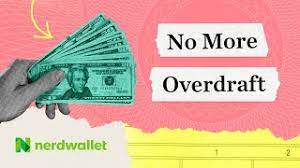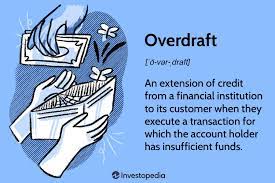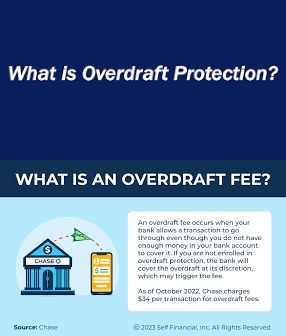Overdraft Fees, News, Key Terms, Resources and Types
Although overdrafts might be annoying, customers have choices about what to do with their bank account in the event of an overdraft.
When a customer makes a transaction that lowers the balance on their account, banks impose overdraft fees. Generally speaking, overdraft costs are between $30 and $35 each incident. If a consumer consistently makes transactions that exceed their account limit, certain banks may impose this fee several times a day. Additionally, some banks impose fees for ongoing negative balances. A fee will be applied to the customer’s account if the funds aren’t refilled in a predetermined amount of time. (If you’re in the market for a new account, check out NerdWallet’s top recommendations for checking accounts.)
Overdraft costs can mount up quickly. In certain cases, individuals who fail to pay their overdraft fees may have their data forwarded to ChexSystems, a reporting system that monitors customers who may be considered high-risk bank customers. It may be quite challenging for you to open a new bank account if you are a member of ChexSystems.
Overdraft costs may be reversed by certain banks for well-standing customers. However, there are alternatives for overdraft coverage and other ways to prevent incurring an overdraft fee if overdrafts continue to be an issue. Discover, Ally, Capital One, and Alliant Credit Union are just a few of the well-known banks and credit unions that have lately lowered or done away with overdraft fees.
Banks that have recently reduced or eliminated overdraft fees

|
Financial institution |
New overdraft policy and fees |
|---|---|
|
Alliant Credit Union |
Alliant Credit Union made the decision to do away with overdraft and nonsufficient funds penalties in 2021. |
|
Ally |
Ally removed overdraft fees in June 2021 and now provides two types of free overdraft protection: its CoverDraft service, which enables users to overdraft up to $100 and has a 14-day window in which to replenish the account, and free overdraft protection transfers from a linked Ally savings or money market account. |
|
Bank of America |
In 2022, Bank of America declared that it would do away with its overdraft protection transfer cost as well as nonsufficient funds fees, commonly referred to as bounced check penalties. The bank lowered its overdraft fee to $10 in May 2022, and it is now only charged twice a day. |
|
Capital One |
Late in 2021, Capital One declared that it would no longer charge its clients for overdraft and insufficient money. |
|
Citibank |
Citibank eliminated fees for returned goods, overdraft protection, and overdrafts in the summer of 2022. |
|
Discover |
Discover eliminated its inadequate money and overdraft fees in 2019. A user can use a free overdraft protection transfer from another Discover account to pay the cost of a transaction if they attempt to make one that might result in an overdraft. |
Banks are ditching overdraft fees

Glossary of overdraft terms
ChexSystems
ChexSystems monitors customer deposit accounts and generates reports on them. If someone has not paid back an overdraft fee, they may be reported to ChexSystems. This means that other banks may refuse to create an account for that person until the five years have passed and the negative mark has been removed from their record.
Continuous negative balance fee
A customer’s bank may impose a continuing negative balance fee until the account is funded if they fail to get their overdraft account back to a positive level.
Nonsufficient funds (NSF) fee.
If an effort is made to complete a transaction that exceeds the amount of funds in an account, the bank will levy a nonsufficient funds fee. Bounced check costs are another name for NSF fees.
Overdraft
A bank customer incurs an overdraft when they make a transaction for more money than what is available in their account.
Overdraft coverage
There are other ways to have overdraft protection, such as transfers of overdraft protection and overdraft lines of credit. By calling their bank and expressing this request, customers are legally permitted to opt out of overdraft coverage. Following this, the bank will simply refuse any transaction that could result in an overdraft.
Overdraft fee
In order to deter overdraft behavior, banks may charge their customers a fee when they overdraft; these fees can range from $30 to $35. If a consumer consistently makes transactions that cause them to overdraft their account, the bank may occasionally charge this fee several times in a day.
Overdraft line of credit
Like a credit card, an overdraft line of credit has a fixed amount of money that a user can draw from in the event that they overspend their account. Using an overdraft line of credit normally carries a high interest cost, similar to that of a credit card, and the interest rate is typically based on your credit score.
Overdraft protection transfer
Customers may link another account to their checking account at some institutions. In this manner, the difference would be deducted from their linked account in the event that they make a transaction that might result in an overdraft.
Overdraft protection transfer fee
Customers who want to transfer money from a linked account to cover a transaction that would otherwise overdraft their primary account may be charged a fee by certain banks.
Prepaid debit card
Because prepaid debit cards don’t allow users to load their cards with cash beyond what is available, they can assist avoid overdraft fees by limiting the number of transactions that can be made.
Second chance checking account
Second chance checking accounts are intended to assist those who have been denied access to standard bank accounts due to incomplete financial records, such as unpaid overdraft fees or placement in ChexSystems. With the use of these accounts, consumers can repair their credit history until any unfavorable entries are removed from their records.
What is an overdraft fee?
When a consumer makes a transaction that takes their account’s available money below what is available, banks levy an overdraft fee. Nonsufficient funds fees, overdraft protection transfer fees, and ongoing negative balance fees are a few costs associated with overdraft fees.
How much do overdraft fees cost?
Depending on the bank’s overdraft policy, overdraft penalties might be assessed several times a day and normally vary from $30 to $35 per instance.
How do I avoid overdraft fees?
There are various methods to prevent overdraft fees:
Opt out
To avoid overdrafting, you can inform your bank that you would prefer a transaction to be denied.
Link an additional account
You can link another checking or savings account to cover the cost of any transaction that would result in an overdraft if your bank permits overdraft protection transfers. Note that this option may come with a cost from certain banks.
Apply for an overdraft line of credit
An overdraft line of credit, or credit line that covers the cost of any transactions that would cause an account to go overdraft, is something that certain banks let their customers open. However, the fact that these credit lines frequently have hefty interest rates makes them comparable to credit cards.
See if your bank has special overdraft coverage
Customers of certain banks are free to overdraft up to a predetermined amount, sometimes even $200, without incurring any fees.
Is it possible to get an overdraft fee refunded?
If you rarely overspend your account and are a client in good standing with your bank, there’s a potential that your bank will reimburse you for any overdraft fees. To discover out, get in touch with the customer service division of your bank.
Is there a limit to how many overdraft fees can be charged per day?
The limits on overdraft fees vary by bank. While some banks only impose this fee once or twice daily, others impose daily overdraft fees that are never-ending.
What is ChexSystems?
Consumer deposit account information is tracked and provided by ChexSystems, a consumer reporting organization. A bank customer may find it more difficult to open a new account elsewhere if their bank reports them to ChexSystems for nonpayment of an overdraft fee.
What overdraft coverage is the best?
Your demands will determine which overdraft protection is appropriate for you, but ideally there shouldn’t be any costs. Generally speaking, an overdraft protection transfer is an easy way to prevent an overdraft fee; but, it won’t be as beneficial if your bank charges for the service. Refusing overdraft protection could be the wisest course of action if you want to completely avoid costs, but it might leave you in a bind if you have an urgent expense to pay for.
What should I look for in an overdraft policy?
Low or nonexistent fees and a wide range of overdraft protection and coverage options characterize the best overdraft policies.
